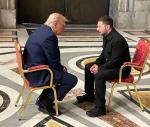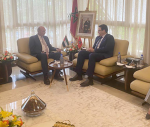You are here
Religious borders
May 30,2013 - Last updated at Feb 06,2018
When writing about social issues in the Arab world, special focus needs to be placed on religion.
Religion has the strongest and most effective impact on the social fabric throughout the region. Many people identify themselves in a religious way, on the basis of their stand on certain religious beliefs.
One of the most apparent social trends nowadays in many Arab societies is the absence of what is perceived as “personal expressions of privacy”. This is due to the strong sense of collectivity, which religions and religious rituals maintain in the individual psyche and social life.
Though the global aim of religions is to spread human values among people at individual level, religious rituals are powerful factors for strengthening the sense of collective identities or illusions of identities.
The pressing collective identities force individuals to sacrifice their personal expressions of privacy, especially in times of high tensions and wars. One of the ways to address this problem is to question the relationship between religion and identity.
The questions that come to mind in this context have to do with what I call the social geography of religious borders: Is religion an identity? Is religion a component of identity? Is religion a source of identity?
One can understand the reasons behind the lack of privacy in the Arab social sphere if the differences among these three questions are looked at carefully.
It is more important to examine how various communities in the region locate themselves within the socio-geographic map of religions, their rituals and manifestations.
From experience in interfaith studies, I can say that a big majority of Arab groups believes that religion equals identity. In this case, religious borders match the borders of society itself.
Members of these groups live their lives and express their being in line with what they think is religion. For them, there is no such thing as “personal”. One is asked to live his or her daily life in accordance with a certain interpretation of religion and religious rituals and practices.
A good number, but not a majority, of social groups departs from this stand. Religion, for them, is only one component of identity. Still, it is a powerful component in their relations with others and to life in general.
Identity in this context is controlled by religion, which colours the other components. Personal manifestations have some space among this category, though it is restricted. In this case, religion occupies a big chunk of the map.
The third category perceives religion as a source of, among others, identity. It is a reference, a guidance tool.
In this case, religion does not control the personal. It becomes personal among other expressions of privacy. In other words, religion is a separate territory that has its special paths towards to the other territory called “individual”. Few in the Arab world belong to this category.
Another way to examine the place of religion in the Arab social life is to look at the illusions of personal fear and security among the different communities.
Some religious leaders instill fear in their followers in order to keep them inside their circle, i.e., collective identity. Such leaders embody religion itself for those followers, and thus they are the source of security.
This is a huge illusion that covers all the map of Arab social life.
Perhaps this gives a hint to why religious fatwas are famous in the region. People need to have a secure opinion from a representative of God regarding their lives. They do not want to decide by themselves. They sacrifice the personal for the sake of feeling secure. But at the same time, most people are sacrificing the meaning of their intelligent existence for illusions.
Religion and illusions of religion have a great control over social trends, problems, issues and dynamics in our part of the world. When religion is everything, then everything else is ignored. A very negative outcome of this reality is that we do not move forward but keep moving around the same old circles.
Such circular movement does not lead anywhere. It only keeps thickening the borders of religion to match the borders of fear itself.
It is when we give religion its normal size and photo by lace in our lives that we can move forward and live our personal intelligent existence.
This is not a call for abandoning religion or religious rituals. It is a mere reminder that life is very diverse and religion is one of its colours.
What happens if you always perceive everything as red or white only?
The writer is media strategist, and interfaith and intercultural specialist. He contributed this article to The Jordan Times.













